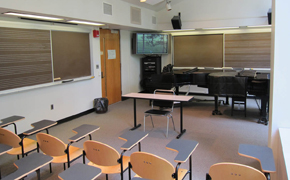This Course at MIT pages are part of the OCW Educator initiative, which seeks to enhance the value of OCW for educators.
Course Overview
This page focuses on the course 21M.235 Monteverdi to Mozart: 1600-1800 as it was taught by Professor Teresa Neff in Fall 2013.
Students studied the music of the seventeenth and eighteenth centuries in terms of context, style and form.
Course Outcomes
Course Goals for Students
Students delivered in-class projects, individual or team presentations, and written assignments.
Instructor Insights
Below Professor Teresa Neff describes various aspects of how she taught 21M.235 Monteverdi to Mozart: 1600-1800.
The assignments for 21M.235 are designed to give students the opportunity to study a specific work in more depth.
Listening Guides
With my comments and suggestions, I hope to encourage my students to explore the topic further . . .
—Teresa Neff
Students are required to create a listenting guide on a work from the assigned listening and give a short presentation to the class. The goal of the assignment is twofold: to reinforce analytical listening skills and to practice describing a musical work. I give a sample listening guide at the beginning of the semester. While guides are to include some historical background on the composer and work, the primary purpose of the assignment is to engage with the compostion in more depth through formal, thematic, and harmonic analysis. The written guide demonstrates this analysis and includes timings from the assigned recording. After the presentation, students are encouraged to ask questions about both the piece and analysis.
Analytical Essay Project
The largest written assignment for 21M.235 is the analytical essay. This assignment requires two drafts of the paper be submitted, which allows students to edit and revise their work. In addition to the written paper, students present their work to each other at the end of the semester. The topic (piece) is chosen by the student. I often meet wtih the student during this process; this provides an opportunity to discuss sources and approaches. I also encourage students to meet with me at any point on the project. The most productive meetings are often after I have returned the first draft of the paper. In the first draft comments, I suggest other avenues of research or approaches to the piece. With my comments and suggestions, I hope to encourage my students to explore the topic further, or, at a later time, pursue ideas beyond the scope of the final project for this class.
Curriculum Information
Prerequisites
21M.301 Harmony and Counterpoint I or permission of instructor
Requirements Satisfied
- CI-M
 subject requirement
subject requirement - This course satisfies requirements for music major, minor, and concentration degrees, but is not required.
Offered
Every fall semester
Assessment
The students' grades were based on the following activities:
 45% Exams (15% each)
45% Exams (15% each) 20% Concert reports (10% each)
20% Concert reports (10% each) 10% Analytical paper
10% Analytical paper 15% Revised and expanded paper
15% Revised and expanded paper 10% Presentations and participation
10% Presentations and participationStudent Information

Breakdown by Year
Primarily undergraduate students
Breakdown by Major
Music majors, minors, and concentrators
Typical Student Background
Almost every student in the class had studied a musical instrument previously, taken other MIT music courses, and currently played in at least one MIT performance ensemble. 1/4 were music majors, and 1/4 were music minors.
During an average week, students were expected to spend 12 hours on the course, roughly divided as follows:
In Class/Lecture
Met 2 times per week for 1.5 hours per session; mandatory attendance.
Out of Class
Reading assignments, listening assignments, score study, and written assignments. Occasional attendance at live music performances.
Semester Breakdown
| WEEK | M | T | W | Th | F |
|---|---|---|---|---|---|
| 1 |  |  |  |  |  |
| 2 |  |  |  |  |  |
| 3 |  |  |  |  |  |
| 4 |  |  |  |  |  |
| 5 |  |  |  |  |  |
| 6 |  |  |  |  |  |
| 7 |  |  |  |  |  |
| 8 |  |  |  |  |  |
| 9 |  |  |  |  |  |
| 10 |  |  |  |  |  |
| 11 |  |  |  |  |  |
| 12 |  |  |  |  |  |
| 13 |  |  |  |  |  |
| 14 |  |  |  |  |  |
| 15 |  |  |  |  |  |
| 16 |  |  |  |  |  |
 No classes throughout MIT
No classes throughout MIT Lecture session
Lecture session No class session scheduled
No class session scheduled Exam
Exam

 Room 1 of 1
Room 1 of 1 